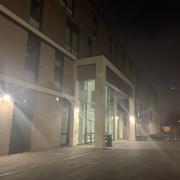
A year has passed since COVID-19 took charge of our lives. The scale of the worldwide pandemic is often hard to comprehend - perhaps a medical mind might make better sense of the global situation?
I was fortunate enough to speak to an oncology registrar who is completing a post registrar fellowship on sarcoma, a very rare type of cancer. Having grown up in Malaysia before moving to the UK to complete her medical education, she holds a unique perspective on health inequities within the field of medicine.
As she trained at the top universities, she noticed that much of what she learnt was not applicable within Malaysia, where people in the public sector would not have had access to the technology for cutting-edge treatments. She soon realised the need for the development of cancer pathways and policy positions for fairer cancer research allocation. Once she finishes her current placement at the end of February, she will focus on how a centre for affordable diagnostics and therapeutics between Malaysia and the UK may be developed, and getting the local policy providers on the ground in Malaysia to realise that they cannot rely on private healthcare as the model for advancing healthcare.
Would you prioritise educating policymakers or the public?
“We are looking for opportunities to link Malaysian doctors and trainees in with other global healthcare programs. We also want to educate policymakers on how to develop cancer services in Malaysia and hopefully try and use them as a model for other countries in South East Asia. It all depends on the government’s cancer policy. In the UK, in 2003, the NHS had a white paper on cancer diagnosis and management, with very specific targets that the government put up about patient pathway, how long it takes to get a patient diagnosed or treated. If a patient is going to their GP with bleeding from the back passage potentially due to colon cancer then there is a 2-week wait target for patients to be referred to a hospital surgeon for a coloscopy and further investigation. If they are found to have colon cancer there is a sixty-day target for surgery, chemotherapy, or radiotherapy for cancer. Targets have been put into place to try and speed up the diagnostic pathway because we know, with cancer, time is important. If a patient is left undiagnosed or untreated beyond a certain time frame, the chances of curing reduce as well. But in Malaysia or other Lower-Middle-Income-Countries, these targets are still not in place, and so, I think coming in and helping to try and develop a system and increasing capacity is important. In Malaysia, they only have 150 oncologists for the whole country of 28 million people, whereas in the UK there are more than eight thousand Oncologists; the proportion of oncologists to patients is vastly different. Furthermore, in the UK almost everybody is within thirty-minutes to an hour of a health centre, whereas in Malaysia some patients may be over eight hours away from the one hospital that can treat cancer. This is where we need to work together with policymakers, the ministry of health, academics, and opinion leaders within the world of medicine to develop a better cancer plan for Malaysia that can become a model for other cases.”
How can the NHS learn from the Malaysian system?
“For a long time, we have been talking about what we export from the UK with almost a colonial, imperial, mentality. We think whatever the UK does is best, we are not as open to learning from other models. I think it is really important to have a respectful and open conversation with colleagues in Lower-Middle-Income-Countries, and for us not treat them as if we are the ones who are delivering the aid but to see what we can learn from them. One thing that inspired me was four years ago when I started up on my research work in Malaysia. Doctors were already implementing a cervical cancer treatment, which was novel, aimed primarily at Asian women and Muslim women because they found that in Malaysia the rate of engagement for cervical cancer screening is very low. Only between 12 to 20 per cent of women were ever having a cervical cancer screen in their lifetime. What that meant was cervical cancer was being diagnosed at a very late stage, and most of the patients came in when they had advanced to stages three or four making it very difficult to treat their cancers. The reason for this was to do with their cultural perspective, and embarrassment – in Malaysia a lot of the doctors might be male, and a lot of the women may not want to go for an intimate examination with male doctors. So, in Malaysia, they devised this system where patients could take their sample by doing a lower vaginal swab themselves, in the privacy of their own home or a separate hospital cubical. This did not involve the regular hospital procedures of speculum examinations by doctors or nurses, and the sample still gets processed to look for HPV DNA. HPV is a virus that can cause cervical cancer, and patients who have prolonged HPV over a 15-to-20-year period are more at risk of developing cervical changes that can then become cancerous. The swab is detecting the DNA that is shed by the virus – a very sensitive test. The pap smear was the traditional way of doing it, taking cells from the cervix to look at abnormalities via cytology, but the sensitivity of a pap smear is only about 50 per cent -whereas the sensitivity of an HPV DNA test is more than 90 per cent, and you only need to test the patients twice in their lifetime, at ages 35 and 45 (the test with the Pap smear must be performed every three years, and you also miss some cancers). At the same time, it was starting to become part of the Malaysian national screening program, and I was very inspired and came back to the UK, and asked why we were not doing this on the NHS. People were still focussing on pap smears did not that patient self-testing would catch on, but this year, the NHS is now behind on 600, 000 cervical cancer screenings, and people are not able to go into hospitals to have their screening as they used to. So now the NHS is going to try and implement the same program that I saw in Malaysia four years ago, which is patient self-swab testing using HPV DNA, sending kits through the post so patients can do this at home and post it back to the hospital, and therefore continue the screening program without patients having to come to hospitals. This is a new thing that has been put into place due to the COVID-19 pandemic. I think that it is interesting because we are now adopting a model that was already adopted in a LIMC country, Malaysia, nearly five years ago due to a pragmatic reason: embarrassment about testing. It is interesting to see the effect upon the London population. In South London, especially around Tooting, there is a very diverse population that is often underrepresented in the current NHS screening program. Now that Londoners can do their tests by themselves without having to come into hospitals for the initial investigation by a healthcare professional, I think we will see an increase in uptake amongst them as well.”
What has caused the BAME inequity amongst COVID patients?
“This is quite a complex and difficult question but it is something we all are very interested in. I think one of the factors is the socio-economic background. We know that when people are less affluent, in less well-paying jobs and having to live in much smaller living quarters with their families, they at higher risk. Some of these people may also suffer from more comorbidities such as high blood pressure, diabetes, and asthma issues. Some of these might go underdiagnosed and undertreated because patients who are in lower-income jobs might not be able to take time off work or due to educational barriers and that might be a form of systemic racism – when some communities find it harder to get the help that they need. We have to look at the genetic side as well; with London being made up of an ethnically diverse population, there could be a genetic factor in the non-Caucasian population that could be triggering their inflammatory response to the virus. In some of the patients admitted to ICU, it was not so much the virus causing them to become so sick but the virus triggering an immune response that was overwhelming their systems and leading to organ failure. Also, I think we found more of the BAME workers held high-risk jobs such as bus drivers (transportations sector), delivery drivers, hospital cleaners, shop workers et cetera. These were some of the groups that were hit hardest. It showed us that there is a clear divide between those who are well off and those who are socio-economically stable, unfortunately spilling over into other areas of health and wellbeing, that it is not just going to stop with the end of the pandemic. I think that the inequalities we see now will widen if we do not make an effort to address some of these really important areas.”
How can we convince those who reject advice, or those who have not received an education, to trust in science?
“I think it comes down to trust. We have an obligation, a duty in terms of our public healthcare engagement, to win the trust of the communities that we work with. And I think there has been a big breakdown in trust because of the way the government has handled the pandemic since March 2020. There seems to have been quite a lot of policy failures and things that could have been done better – when the pandemic first broke out, there was a lot of mixed messaging over whether or not we should be wearing masks at the time, and how virulent the virus was or was not. I think that led to a lot of people losing faith in the government in terms of its ability to guide us and give us clear information. There are lots of double standards as well, we saw some Ministers and MPs flouting the lockdown rules, and not being reprimanded, and on the other hand, we saw deprivation – we might see four or five children living in one council flat over a year, with their parents unable to take them anywhere, having to struggle with that as well. So, I think the way to get around this now is to have a very clear message, within our communities, and we need the government to go down to a community level to start to rebuild those bridges where there has been a breakdown of trust or a misunderstanding; I also think we need to engage community champions.
For example, in the cultural communities in South London, maybe we should be trying to get some of the community leaders to come together and be briefed by doctors on the science and the reasons why we need to encourage vaccination and mask-wearing amongst the population. It has also been very difficult during the pandemic to be seen in a GP surgery. We now need to make an effort to allow the GPs to get involved in the vaccination program, and hopefully through the GPs and nursing programs to be able to reach out because they know the communities that they serve, the patients that are on their books.
Maybe, in the current social media generation, we need to also engage in social media icons or people who are respected by the younger population to get them to spread a positive message on how to manage things during the lockdown, how to abide by the rules, to wear masks. The messages on TV are good but we need to make sure we have that good ethnic representation, and also in terms of age groups, we need to make sure we get that message out to the youth as well. For such a long time the pharmaceutical industry has not had the best image of researching an altruistic way, not democratising access to medicine – I think there should be a way that the vaccine can be made open access for many different countries, giving them the manufacturing capacity, avoiding a situation where the vaccine is limited to countries who can afford to pay at present.
The pandemic is a global problem, and it requires a global solution, and we are not going to get on top of it if we only vaccinate people in higher-income countries, as this will only lead to other variants, and the vaccines will become useless. I always like to go back to the model of the human genome project, as they managed to sequence the entire human genome, 28,000 genes in eight years, with international collaboration between academic centres, governments and the pharmaceutical industry, but nobody patented any genes, any available information was unloaded onto an open-access server so that everyone could benefit from the information that as being generated as part for the project. This helped our understanding of many diseases, including non-communicable diseases, neurological conditions, cancers, and others, and then that led to the further discovery of treatments for many of these diseases as well. But had everyone been trying to protect their findings, that opening up of the space for science would never have happened. In a similar vein, I feel that when it comes to vaccine development, production, and rollout, everyone needs to work together and find global solutions, and this needs demanding more from governments, pharmaceutical companies, and also academics - because a lot of the time academics aren’t very good at communicating what goes on their research universities, and it is sometimes a bit of an ‘ivory tower’ mentality, where academics might be quite protectionist and competitive, and not share and collaborate. This cannot be achieved unless we are more open to sharing knowledge. We need all these vaccine producers to come into an agreement with all the manufacturing facilities around the world and say that they will provide the technology – of course, there needs to be some payment by governments, but everyone will be allowed to manufacture at a cost that is affordable for their country to vaccinate your whole population.
If this is achieved, we could potentially vaccinate the global population by the end of 2021 – but as we are currently going many countries will not even see a vaccine until 2022, and at that point how many escape variants will we have? How many millions more people will have died? Essentially, the vaccines may become ineffective. There is the same problem with cancer. Many cancers have good solutions but a course of chemotherapy may cost many thousands of pounds, and a course of immunotherapy may cost hundreds of thousands of pounds, and CAR-T Cell therapy can be 480, 000 USD at present. So that is the kind of treatment we cannot afford in the NHS for some patients and is completely beyond the capacity of Lower-Middle-Income-Countries’ budget. We also need to look at the profit margin that pharmaceutical companies are making on these drugs, and I think at the moment they have calculated that it costs a billion dollars to go from bench to bedside for a single drug, and it can take ten to fifteen years. A lot of drugs that get developed never actually make it into clinics because of efficacy or safety issues. I understand that it is an expensive area to do research and development, but at the same time, you have pharmaceutical companies who are making big profits from these drugs whilst patients are dying whilst waiting. We need to unite governments, academics, pharmaceutical industries, and the public, to look at how we can solve this problem, and not just continue giving the latest treatments just to those who can pay, because that does not seem like a fair way of doing it.”
Her answers were very insightful.



























